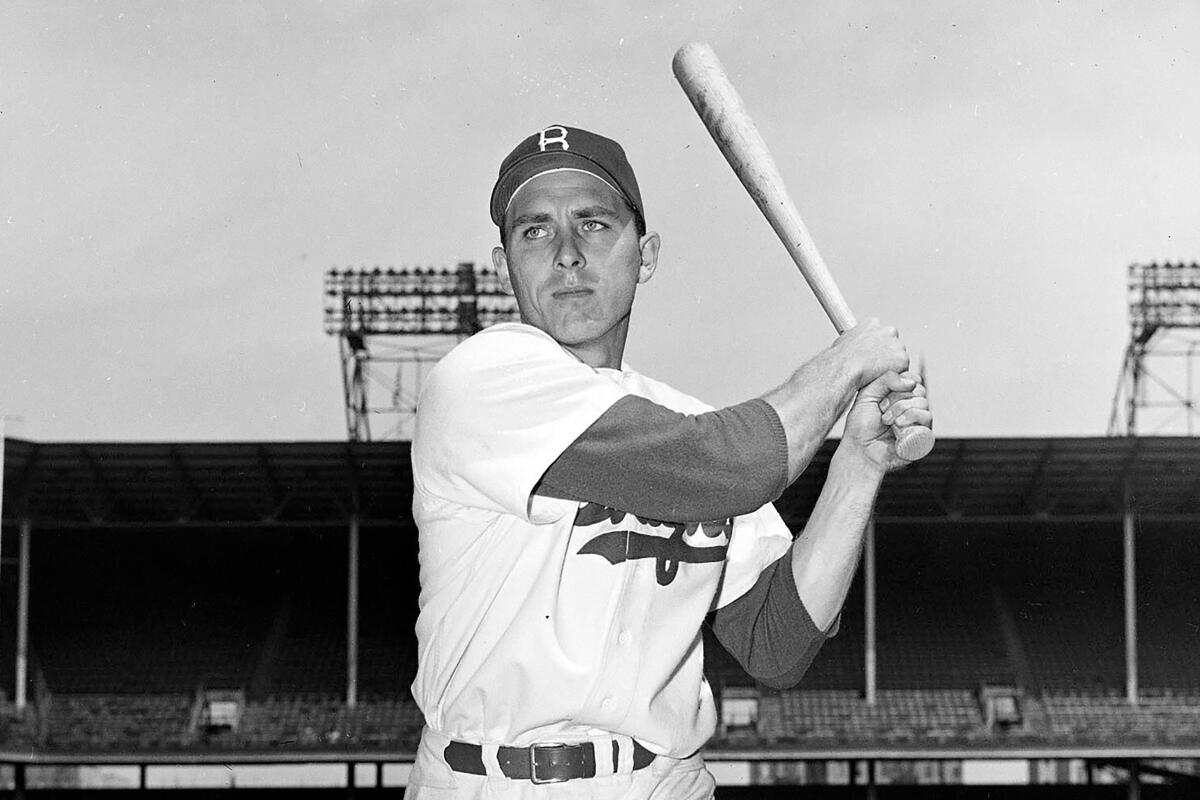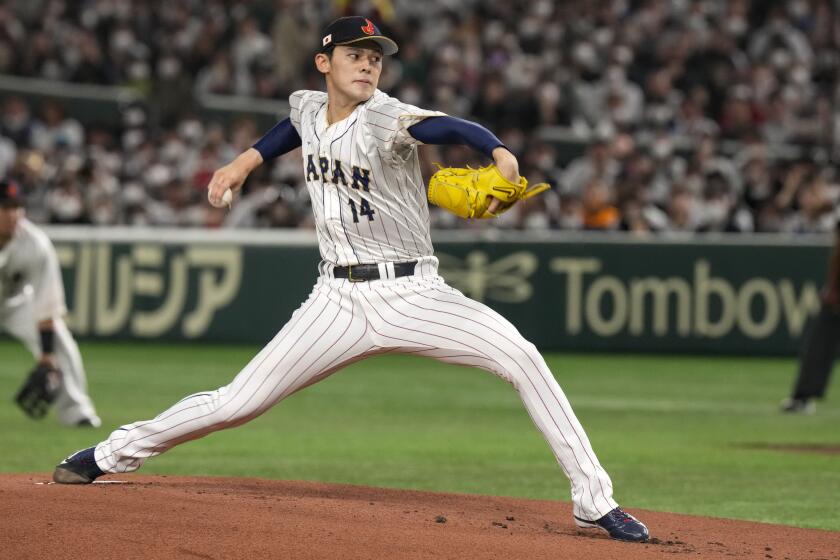Dodgers Dugout: The 25 greatest Dodgers of all time, No. 13: Gil Hodges

Hi, and welcome to another edition of Dodgers Dugout. My name is Houston Mitchell as we continue the top-25 countdown.
Are you a true-blue fan?
Get our Dodgers Dugout newsletter for insights, news and much more.
You may occasionally receive promotional content from the Los Angeles Times.
Readers voted in droves, submitting 15,212 ballots by email, Twitter and Facebook. Voters were asked for their top 10 Dodgers in order from 1 to 10, with first place receiving 12 points, second place nine points, third place eight, all the way down to one point for 10th place.
The last time we did this was in 2018, and there were some changes in the rankings.
So, without further ado:
Enjoying this newsletter?
Your support helps us deliver the news that matters most. Become a Los Angeles Times subscriber.
The 25 greatest Dodgers, No. 13: GIL HODGES (4 first-place votes, 17,042 points)
2018 rank: 13th
Finally, Gil Hodges is a Hall of Famer.
Hodges made his debut with the Dodgers in the final game of the 1943 season. And it could have been his final game ever, as he joined the Marines after the season ended and was a gunner for the 16th Anti-Aircraft Battalion. In April 1945, Hodges and his battalion stormed the beaches of Okinawa and was involved in heavy fighting. He was awarded a Bronze Star for heroic service in a combat zone. In a letter to his family, Hodges wrote about the experience.
“We arrived here [Okinawa] the first of April and things really cut loose. We were always having air attacks and the ships were really knocking down the planes. It’s just like being tied down when you’re on board a ship because you can’t do a thing but just stand there and wait for something to happen. One Japanese plane, a Zero, came circling around where we were anchored and when everyone saw it they really cut loose. I don’t see how it was possible for him to escape with so much firing being done at that time. He was the plane that really gave all of us a scare. He started to pull away from the firing and then he got hit and started circling around, then into a suicide dive. He started coming down and boy he was really moving. He crashed on the bow of another LST not very far from our ship and exploded. I don’t know how many got hurt but I’m sure there were quite a few. Well, that’s just one incident and I don’t want to go into any other at the present time because I could probably sit here and write all day and still not be through.”
You can read more about Hodges’ time in the Marines here.
Hodges was discharged before the 1946 season and returned to the Dodgers. He spent 1946 in the minors, but came up to the majors in 1947 to stay. He broke in as a catcher, but with the Dodgers wanting to get his bat in the lineup and realizing he would never be better behind the plate than Roy Campanella, they converted him to first base before the 1948 season. As manager Leo Durocher said, “I put a first baseman’s glove on our other rookie catcher, Gil Hodges. Three days later I’m looking at the best first baseman I’d seen since Dolph Camilli.”
Hodges hit at least 20 homers in 11 consecutive seasons and drove in at least 100 runs in seven consecutive seasons.
He was the most loved member of the Boys of Summer Dodgers, or as teammate Clem Labine put it, “Not getting booed at Ebbets Field was an amazing thing. Those fans knew their baseball, and Gil was the only player I can remember whom the fans never, I mean never, booed.”
In 1952, Hodges went 0 for 21 in the World Series, but even then, the fans remained solidly on his side. Hodges wrote about it in his book “The Game of Baseball,” saying, “The thing that most people hear about that one is that a priest stood in a Brooklyn pulpit that Sunday [during the World Series] and said, ‘It’s too hot for a sermon. Just go home and say a prayer for Gil Hodges.’ Well, I know that I’ll never forget that, but also I won’t forget the hundreds of people who sent me letters, telegrams and postcards during that World Series. There wasn’t a single nasty message. Everybody tried to say something nice. It had a tremendous effect on my morale, if not my batting average. Remember that in 1952, the Dodgers had never won a World Series. A couple of base hits by me in the right spot might have changed all that.”
Hodges died on April 2, 1972. He was managing the Mets at the time (Hodges was the manager of the 1969 “Miracle Mets), and had just completed a round of golf with his coaches. He was walking to his motel room and collapsed of a massive heart attack. Coach Joe Pignatano rushed to his side. Hodges was bleeding heavily from the back of his head, which he had hit on the pavement when he fell. “I put my hand under Gil’s head, but before you knew it, the blood stopped. I knew he was dead. He died in my arms.”
Hodges was only 47 years old.
After never being voted into the Hall of Fame in his 15 years on the regular ballot, Hodges was elected by the Golden Era Committee in 2021. “It’s a great thing that happened for our family,” Gil Hodges Jr. said. “We are all thrilled that Mom got to see it, being 95. We’ve all waited a long time, and we are just grateful and thankful that it’s finally come to fruition.”
A final word, from Tom Seaver, who played for Hodges with the Mets. “Gil Hodges was the most important person in my career. Above all, he taught me how to be a professional.”
Previously
And finally
Gil Hodges vs. Willie Mays on the old “Home Run Derby” TV show. Watch and listen here.
Until next time...
Have a comment or something you’d like to see in a future Dodgers newsletter? Email me at [email protected], and follow me on Twitter at @latimeshouston. To get this newsletter in your inbox, click here.
Are you a true-blue fan?
Get our Dodgers Dugout newsletter for insights, news and much more.
You may occasionally receive promotional content from the Los Angeles Times.




